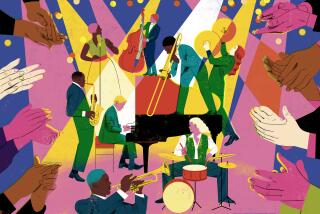REVIVE: Yugoslavia Town : Music Revives Town in Yugoslavia
GROZNJAN, Yugoslavia â Music has been known to restore the weary, uplift the downtrodden and even cure the temporarily maladjusted. But revive a town? It seems that music can do that, too.
Were it not for music, time and neglect would have killed this medieval town in northwestern Yugoslavia. Instead, painters who discovered the charms of its winding streets and quiet courtyards established ateliers. A few years later, young musicians from all over the world revived the townâs soul.
Thanks to their efforts, Groznjanâs population is growing steadily as are the numbers of visitors who, every summer, discover its charms.
Surrounded by stone ramparts dating to the 15th and 16th centuries, Groznjan sits atop a hill in the center of Yugoslaviaâs Istrian Peninsula. Around it the lush countryside unfolds in a succession of green valleys and low hills. At irregular intervals, rocky patches rip through this thick blanket of vegetation.
Flora has competed with stone on this peninsula since the beginning of civilization, millenia before Groznjan made its appearance in historical records as a medieval, fortified settlement in 1103. Since then the town has changed hands several times: Charlemagneâs vassals until the 14th Century, Venice, the Austro-Hungarian Empire, Napoleonic France and Italy. At the end of World War II it became a part of Titoâs Yugoslavia.
Cobblestone Streets
Groznjanâs main gate bears the Venetian seal and a few of the houses along Groznjanâs narrow, cobblestone streets survive from the 13th and 14th centuries. Mostly, however, Groznjanâs architecture bridges the 15th and 18th centuries.
To the right of the main entrance stands a purely Renaissance loggia below what used to be the town granary. The baroque Church of Saints Mary, Vitus and Modestus presides over the townâs main square. The artwork inside the church traces a similar progression, from Renaissance choir stalls to a late Baroque altar in marble.
âGroznjan shared the fate of many Istrian towns, which were abandoned after the Second World War,â says Vladimir Ukraincik, director of the Institute for the Protection of Monuments in the Yugoslav Republic of Croatia. In the early 1950s many of Istriaâs Italian families chose to emigrate, their cultural and linguistic ties to Italy proving stronger than their attachment to the land.
More young people left for tourist centers along the Dalmatian coast or north to Austria and Germany, where their labor commanded higher prices. By the early â60s Groznjan counted only 10 older hangers-on, and about 80% of its buildings stood abandoned.
âIt became a question of either surrendering this town to oblivion,â Ukraincik says, âor doing something to reverse the trend.â
An Artistsâ Town
Painters and sculptors took the initiative by having Groznjan officially recognized as an artistsâ town in 1965. In practical terms, this meant state funding for the restoration and conversion of old houses into studios and galleries. As a result, a handful of artists made Groznjan their summer workplace.
But more was needed to bring life back to the townâs all too quiet streets. The International Federation of the Jeunesses Musicales happened to be looking for an âoasis of silence,â as former member Carlos Rego put it.
âWe wanted to create a sort of musical research center, a place where federation leaders of different countries could work together,â recalled the former secretary general of the federation, Adelain Donet.
Through UNESCO, Yugoslavia offered Groznjan. âIt was ideal: It had beauty, peace and a mix of cultures--Venetian, Italian, Austrian, Slavic.â In June, 1969, at a meeting in Budapest, Groznjan became an official federation project.
The next summer young musicians and aficionados from all over the world lugged sleeping bags and instruments up the dirt road to Groznjan. In consultation with restoration experts they replaced caved-in roofs, cleaned out debris, replastered facades and ushered centuries-old houses into the 20th Century by installing electricity and plumbing.
At dayâs end, plumbers and plasterers unwrapped their musical instruments and gathered under the loggiaâs graceful arches or in the main square. From this romantic vantage point they filled the evening air with the sounds of chamber music, jam sessions, solos. A hearty handful would often greet the dawn with varied melodies.
Musicians Tarry
Now music echoes in Groznjanâs winding street all summer long, day or night. Between the end of June and the beginning of September more than 700 young musicians tarry a while in Groznjan to take part in courses and workshops.
These are baroque music for cellists, classes in sitar for guitarists, master classes in organ, flute, harpsichord, violin, piano. Sounds as varied as jazz, electronic music and Istrian folk tunes spill through open windows into the stone-lined streets.
Alexandra Wagner, who took over the organization of the camp in 1986, has broadened the program.
âThis year,â she says, âwe are going to put on a musical which was written by Norwegian, Swedish, Danish and Yugoslav musicians.â Wagner has also overseen the incorporation of music-related activities: modern and African dance, workshops on the promotional aspects of cultural events, puppet theater, and yoga for the artistsâ peace of mind.
âAt first the inhabitants were a little leery of all this activity,â says Ukraincik, who has been coming to Groznjan regularly for 15 years. âBut now they wish the program would last year round.â
Be it a jazz evening led by Yugoslav artist Bosko Petrovic, who regularly performs in festivals in the United States, or the Swedish mixed choir 34 Kor, the older residents crowd around to listen. In the noisy milling that follows every good performance, their comments uttered in an Italian patois mingle with the erudite pronouncements of young artists and older professors.
Younger couples from the surrounding areas bring their children, and some have elected to move to Groznjan. Within easy commuting distance to factories, Groznjan offers clean living, entertainment, cultural exposure and summer employment opportunities.
Potters and ceramists, painters, sculptors and graphic artists have opened ateliers and galleries within the medieval ramparts.
In summer, tour buses climb the paved road up the hill. The musicians and residents directed the development of tourism to preserve Groznjanâs special atmosphere. âFor a while,â Ukraincik said, âtourists would come to have dinner in the open area beside the main square. There was even a disco, but all this proved too disruptive.â
The restaurant still exists and continues to serve its specialty, mushrooms grown, the story goes, in a tunnel where Benito Mussolini, former dictator of Italy, had train tracks ripped out and sent to Ethiopia. But the disco has disappeared, giving way to a concert/rehearsal hall.
Waking Up
With nearly 50% of its buildings renovated, an artistâs association with about 60 names on its roster and a permanent population of about 10 families, Groznjan is certainly waking up. âWe continue to dream,â admits Donet from his office in Brussels. âBut we must be realistic. The town has been saved; now comes phase two, its maintenance.â
The young musicians who make room in their summer plans for a course in Groznjan, as well as visitors who drive inland from the Dalmatian coast to attend a performance, all share Donetâs dreams for Groznjan. Like the officials of the international federation, they pursue their vision with love and dedication.
âThere have been other restoration projects throughout Istria,â Ukraincik says. âBut Groznjan, thanks to the impetus of the music camp, is by far the most developed.â
As one-time federation member and Groznjan aficionado Carlos Rega put it: âWhen you group musicians in one place and let them loose, theyâll do what they love most--theyâll make music.â In the process they have helped to create a center for the arts and revive a dying town.
For further information, contact the Yugoslavia National Tourist Office, 630 Fifth Ave., Suite 280, New York 10111, or phone (212) 757-2801.
More to Read
Sign up for Essential California
The most important California stories and recommendations in your inbox every morning.
You may occasionally receive promotional content from the Los Angeles Times.










